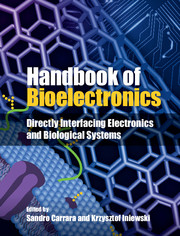Book contents
- Frontmatter
- Contents
- List of Contributors
- 1 What is bioelectronics?
- Part I Electronic components
- Part II Biosensors
- Part III Fuel cells
- Part IV Biomimetic systems
- Part V Bionics
- 22 Introduction to bionics
- 23 Bioelectronic interfaces for artificially driven human movements
- 24 The Bionic Eye: a review of multielectrode arrays
- 25 CMOS technologies for retinal prosthesis
- 26 Photovoltaic retinal prosthesis for restoring sight to the blind
- Part VI Brain interfaces
- Part VII Lab-on-a-chip
- Part VIII Future perspectives
- Index
- References
24 - The Bionic Eye: a review of multielectrode arrays
from Part V - Bionics
Published online by Cambridge University Press: 05 September 2015
- Frontmatter
- Contents
- List of Contributors
- 1 What is bioelectronics?
- Part I Electronic components
- Part II Biosensors
- Part III Fuel cells
- Part IV Biomimetic systems
- Part V Bionics
- 22 Introduction to bionics
- 23 Bioelectronic interfaces for artificially driven human movements
- 24 The Bionic Eye: a review of multielectrode arrays
- 25 CMOS technologies for retinal prosthesis
- 26 Photovoltaic retinal prosthesis for restoring sight to the blind
- Part VI Brain interfaces
- Part VII Lab-on-a-chip
- Part VIII Future perspectives
- Index
- References
Summary
Introduction
The notion of creating artificial vision using visual prostheses has been well represented though science fiction literature and films. When we think of retinal prostheses, we immediately think of fictional characters like The Terminator scanning across a bar to assess patrons for appropriately fitting clothing, or Star Trek’s Geordi La Forge with his VISOR, a visual instrument and sensory organ replacement placed across his eyes and attached into his temples to provide him with vision. Such devices are no longer farfetched. In the past 20 years, significant research has been undertaken across the globe in the race for a “Bionic Eye”. Advances in Bionic Eye research have come from improvements in the design and fabrication of multielectrode arrays (MEAs) for medical applications. MEAs are already commonplace in medicine with use in applications such as the cochlear device, cardiac pacemakers, and deep brain stimulators where interfacing with neuronal cell populations is required.
The use of MEAs for vision prostheses is currently of significant interest. For the most part, retinal prostheses have dominated the research landscape owing to the ease of access and direct contact to the retinal ganglion nerve cells. However, MEAs are also in use for direct stimulation into the optic nerve [1]. Retinal prostheses bypass the damaged photoreceptor cells within the retina and instead replace the degenerate retina with electrical stimulation to the nerve cells. Using electrical stimulation, stimulated retinal ganglion cells have been shown to elicit a percept in the form of a phosphene in blind patients [2–6]. Accordingly, the two diseases commonly linked to the justification for Bionic Eye research are age-related macular degeneration (AMD) and retinitis pigmentosa (RP), diseases which lead to progressive loss of photoreceptor cells and diseases where the patient has had previous vision and thus exhibits prior visual-brain pathways. At present, there has been no reliable cure for any of the retinal diseases that target the photoreceptor cells, and thus the development of prosthetic devices is a viable clinical treatment option [7–9].
- Type
- Chapter
- Information
- Handbook of BioelectronicsDirectly Interfacing Electronics and Biological Systems, pp. 294 - 312Publisher: Cambridge University PressPrint publication year: 2015
References
- 1
- Cited by



